Why aren't all rules good rules?
From its creation, the United States was different from its European predecessors. Its people were not united by a common heritage, ethnicity or even language. It was then, as it is now, a diverse nation of immigrants. What united it was a radical belief of the time, that "all men are created equal," and that a free people could govern themselves and not descend into anarchy and chaos. For centuries, European nations had monarchs and aristocracies to maintain order and stability from generation to generation. The United States declared that its people would be governed only by their elected representatives. This belief in democracy, as one British commentator observed, created in the United States "a nation with the soul of a church," united by a common belief.
Framework of U.S. Democracy
Three documents have been central to the essence of this perception. The Declaration of Independence was drafted by the Second Continental Congress in 1776 in Philadelphia to explain and justify why the colonies were separating themselves from the domination of Great Britain. Delegates from 13 colonies along the Atlantic Coast sent delegates to the convention in Philadelphia. They approved a resolution to separate themselves from Britain and appointed a committee of five men to draft an explanation to the world why the colonies were taking this step. The committee chose Thomas Jefferson of Virginia to write the original draft. He began with an explanation of why governments are established and then moved on to the injustices the colonies had endured by Parliament and the king. The document ends with the declaration that the colonies were from now on free from British rule. It was approved by the Continental Congress on July 4, America's Independence Day. It declares that "all men are created equal and endowed by their Creator with certain inalienable rights." The nation has never fully lived up to that bold statement in practice, but it is the measure against which perceived injustices are measured.
The former colonies that defeated the British Empire needed to establish some legal framework that would bind them together for certain purposes but not become as oppressive as the monarch they had just defeated. At first, the Articles of Confederation provided a weak central government but pressure for a stronger authority developed quickly. In 1787, delegates to a Constitutional Convention began meeting to strike a balance between responsibilities left to the states and those delegated to the federal government.
Like the Declaration of Independence, the U.S. Constitution begins with a preamble that sets forth its purpose — "to form a more perfect union." Federal authority is divided into three branches: the legislative branch that makes the laws; the executive that administers the laws; and the judicial that interprets the laws in cases of conflict. Central to the Constitution is the concept of checks and balances. Each branch has some authority to curb undue power exercised by the other two branches. Some duties were specifically delegated to the federal government and some specifically reserved to the states. The Convention specified that the plan would go into effect when nine states approved it. New Hampshire was the ninth in 1788, and Rhode Island was the last in 1790. George Washington was elected as the first president in 1788.
Ever concerned that the central government could abuse the rights of the people as the colonists felt Great Britain had done, Congress proposed a series of amendments to the Constitution that specifically spelled out restrictions on the federal government. The first 10 amendments to the Constitution are called the Bill of Rights, including the First Amendment, which states that individuals shall have the right to freedom of speech, religion, the press and assembly and the right to petition the government.
These three documents are central to how the United States presents itself to its own people and to the world. They have been copied by many emerging democracies around the world and show remarkable resilience over the 250 years since their adoption.
Supporting Questions
What key documents establish the foundation of America's participatory democracy?
- "The Great Law of Peace" Video about Injunuity, November 12, 2013 (Video)
- Declaration of Independence, July 4, 1776 (Document)
- Preamble to the U.S. Constitution, September 1787 (Document)
- U.S. Constitution, September 1787 (Document)
- Bill of Rights in the U.S. Constitution, September 25, 1789 (Document)
- Iowa Constitution, 1857 (Document)
- Independence Hall in Philadelphia, Pennsylvania, ca. 1900 (Image)
How are laws created?
- "How Does a Bill Becomes a Law" Infographic (Document)
- "The Three Branches of Government and How They Work in Iowa" (Document)
- Comparing Three Branches of Government in Iowa Versus the U.S. (Document)
- Marbury v. Madison, 1803 (Document)
- Architect's Drawing of the Iowa State Capitol, ca. 1880 (Image)
- Supreme Court Building in Washington, D.C., ca. 1980 (Image)
- The White House in Washington, D.C., ca. 1980 (Image)
- Aerial View of the U.S. Capitol in Washington, D.C., April 30, 2007 (Image)
How can laws be changed to guarantee human rights?
- Iowa Supreme Court Ruling on Montgomery v. Ralph, 1839 (Document)
- "Declaration of Sentiments" Address by Elizabeth Cady Stanton in Seneca Falls, New York, July 1848 (Document)
- Illustrated Portraits of Dred Scott and His Family, Harriet, Eliza and Lizzie, 1857 (Image)
- Arabella (Belle) Babb Mansfield, First Certified Female Attorney in the United States (Document, Image)
- Iowa Supreme Court Rules on Equal Access: Portrait of Alexander Clark, 1868 (Document, Image)
- Ola Babcock Miller, Iowa's First Secretary of State (Image)
- "Mennonite School Teacher with Class of Amish, Mennonite and Pennsylvania Dutch Children," March 1942 (Image)
- "Republican Senators During a Meeting on Amendments to the Civil Rights Act," May 20, 1964 (Image)
- Participants at a Civil Rights March from Selma to Montgomery, Alabama, 1965 (Image)
- "D.M. Schools Ban Wearing of Viet Truce Armbands" Newspaper Article, December 15, 1965 (Document)
- President Lyndon B. Johnson Signs 1968 Civil Rights Act, April 11, 1968 (Image)
- March in Support of Migrant Workers in Des Moines, Iowa, February 1969 (Image)
- News Release from Muscatine Community Effort Organization about H. J. Heinz Company Boycott, 1969 (Document)
- "Iowa Constitution and Race" from Iowa PBS, 1978 (Video)
- "Religious Rights" Essay from The Goldfinch, February 1987 (Document)
- "The Black Armband Case" Essay from The Goldfinch, February 1987 (Document)
- Iowa Supreme Court Case Varnum v. Brien, April 3, 2009 (Document)
- "Celebrating Ten Years of Marriage Equality in Iowa—Yes, Iowa," April 3, 2019 (Document)
| Government, Democracy and Laws Teaching Guide |
| Printable Image and Document Guide |
Iowa Supreme Court Case Varnum v. Brien, April 3, 2009

Download Resource Download Resource
Description
Varnum v. Brien was a 2009 Iowa Supreme Court case in which the Court unanimously agreed that the state's limitation of marriage to opposite-sex couples violated the equal protection clause of the Iowa Constitution. The case made same-sex marriage legal in Iowa.…
"Celebrating Ten Years of Marriage Equality in Iowa—Yes, Iowa," April 3, 2019

Download Resource Download Resource
Description
April 3, 2019, marked the 10th anniversary of the Varnum v. Brien decision from Iowa’s Supreme Court, which legalized same-sex marriage in the state of Iowa. They were only the third state in America to recognize marriage equality, and were the first to do so with a…
News Release from Muscatine Community Effort Organization about H. J. Heinz Company Boycott, 1969

Description
Activists from the 150-member Muscatine Community Effort Organization (CEO) worked to expose poor working and living conditions for migrant workers and their children in the Muscatine area. For this specific protest, activists from CEO joined forces with the…
"D.M. Schools Ban Wearing of Viet Truce Armbands" Newspaper Article, December 15, 1965
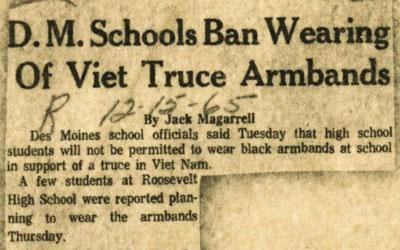
Description
This article from The Des Moines Register was entered as defendants' Exhibit 2 in John F. Tinker et. al. v. The Des Moines Independent Community School District et. al. It describes the decision of Des…
"The Black Armband Case" Essay from The Goldfinch, February 1987

Description
In the 1960s, some Des Moines students tested the U.S. Constitution's definition of freedom of speech. A few students wore black armbands to school to support a truce (period of peace) in the Vietnam War (1965-73). Black armbands are a symbol of sadness that are sometimes…
"Religious Rights" Essay from The Goldfinch, February 1987

Description
In Hazelton, Iowa, local school officials tried to force Amish children to board a bus to go to a public school in November 1965. Amish parents protested, and Amish kids scrambled terrified into nearby cornfields. They did not want to attend the public schools. The State of…
"The Great Law of Peace" Video about Injunuity, November 12, 2013

Description
Much has been said about the inspiration of the ancient Iroquois "Great League of Peace" in planting the seeds that led to the formation of the United States and its representative democracy. The Iroquois Confederacy, founded by the Great Peacemaker in 1142, is the oldest…
Declaration of Independence, July 4, 1776

Description
The Declaration of Independence was the first formal statement by a nation’s people asserting their right to choose their own government. When the first skirmishes of the Revolutionary War broke out in Massachusetts in April 1775, few people in the American colonies wanted…
Preamble to the U.S. Constitution, September 1787

Description
The preamble is the opening statement to the U.S. Constitution. The preamble explains the reasons why the framers of the Constitution made the government a republic. The preamble, along with the rest of the U.S. Constitution, was written over a period of about six weeks,…
U.S. Constitution, 1787

Download Resource Download Resource
Description
The Constitution of the United States is the supreme law of the United States of America. The Constitution was originally created with seven articles, and it is the national frame of government. Its first three articles embody the principle of the separation of powers,…
Bill of Rights in the U.S. Constitution, September 25, 1789
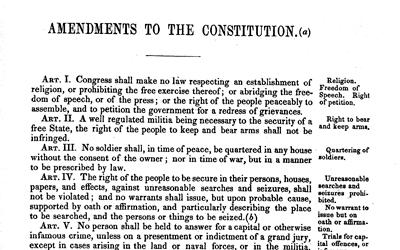
Download Resource Download Resource
Description
On September 25, 1789, the first Congress of the United States proposed 12 amendments to the U.S. Constitution. Ten of the proposed 12 amendments were ratified by three-fourths of the state legislatures on December 15, 1791. The ratified articles (Articles 3–12) constitute…
Iowa Constitution, 1857
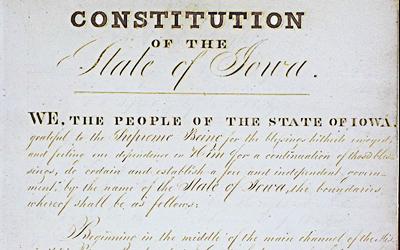
Description
The Iowa Constitution is the plan for the state government. The plan tells how the government should be organized and who has certain duties. Iowa's first constitution was written when Iowa entered the Union as a state in 1846. It was different from the rules of government…
Independence Hall in Philadelphia, Pennsylvania, ca. 1900

Description
Independence Hall can be considered as one of the birthplaces of the United States. In this building, the Declaration of Independence and U.S. Constitution were both debated and signed. The legacy of the nation's founding documents began here. It is a place that has…
"How Does a Bill Become a Law?" Infographic

Description
After both the U.S. House and U.S. Senate have approved a bill in identical form, the bill is sent to the president. If the president approves of the legislation, it is signed and becomes law. If the president takes no action for 10 days while Congress is in session, the…
"The Three Branches of Government and How They Work in Iowa"

Description
The three branches of Iowa's government mirror the three branches of the U.S. government. There is the executive branch, which includes the governor and other staff, and duties can include approving or vetoing bills, administering or carrying out laws and can recommend…
Comparing Three Branches of Government in Iowa Versus the U.S.

Download Resource Download Resource
Description
The federal and Iowa government is composed of three distinct branches: legislative, executive and judicial, whose powers are vested by the U.S. Constitution and Iowa Constitution.
Marbury v. Madison, 1803

Download Resource Download Resource
Description
The 1803 U.S. Supreme Court case Marbury v. Madison established the principle of judicial review — the power of the federal courts to declare legislative and executive acts unconstitutional. The unanimous opinion was written by Chief Justice John Marshall.…
Architect's Drawing of the Iowa State Capitol, ca. 1880

Description
With the influx of settlers to Iowa, citizens felt the state's capital should be moved to a more central location. The Iowa General Assembly chose Des Moines as the new city. The Iowa State Capitol is also called the Iowa Statehouse. As the seat of the Iowa General Assembly…
Supreme Court Building in Washington, D.C., ca. 1980

Download Resource Download Resource
Description
The U.S. Supreme Court of the United States is the highest court in the federal judiciary of the United States. Established by the U.S. Constitution, the Supreme Court began to take shape with the passage of the Judiciary Act of 1789 and has enjoyed a rich history since its…
The White House in Washington, D.C., ca. 1980

Download Resource Download Resource
Description
The White House is the official residence and workplace of the president of the United States. It is located at 1600 Pennsylvania Avenue NW in Washington, D.C., and has been the residence of every U.S. president since John Adams in 1800.
Aerial View of the U.S. Capitol in Washington, D.C., April 30, 2007

Description
The United States Capitol, often called the Capitol building, is the home of the U.S. Congress and the seat of the legislative branch of the federal government. Congress has two parts: the U.S. Senate and the U.S. House of Representatives. Each state has two U.S. senators…
Iowa Supreme Court Ruling on Montgomery v. Ralph, 1839

Description
This document is the written judgment from Iowa Supreme Court Chief Justice Charles Mason, who in 1839 ruled that a former enslaved man named Ralph would be "...free by operation of law; it is therefore ordered and adjudged; that he be discharged from further duress and…
"Declaration of Sentiments" Address by Elizabeth Cady Stanton in Seneca Falls, New York, July 1848

Description
The Declaration of Sentiments from the Seneca Falls Convention, using the model of the U.S. Declaration of Independence, forthrightly demanded that the rights of women as right-bearing individuals be acknowledged and respected by society. It was signed by 68 women and…
Illustrated Portraits of Dred Scott and His Family, Harriet, Eliza and Lizzie, 1857

Content Warning: Please be aware of the use of extremely derogatory language used in this historical document.
Description
The Supreme Court decision Dred Scott v. Sandford was issued on March 6, 1857. Delivered by Chief Justice Roger Taney, this opinion declared that…
Arabella (Belle) Babb Mansfield, First Certified Female Attorney in the United States
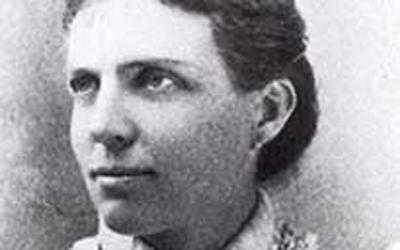
Description
Arabella "Belle" Babb Mansfield was born on August 23, 1846, in Des Moines County, Iowa. Her family moved to Mount Pleasant, Iowa, in 1860 when her father died. She graduated from Iowa Wesleyan College in 1866. She studied law for two years at her brother's law office.…
Iowa Supreme Court Rules on Equal Access: Portrait of Alexander Clark, 1868

Description
Iowa’s first constitution of 1846 required blacks to pay a $500 bond to enter the state and stopped them from voting, holding office, serving in the state militia, attending public schools and marrying whites. Alexander Clark participated in a campaign for voting rights in…
Ola Babcock Miller, Iowa's First Secretary of State
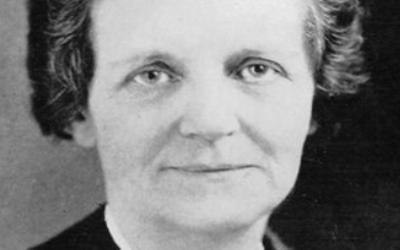
Description
Ola Babcock Miller was Iowa's first female Secretary of State. Initially elected in 1932, she was reelected twice. Miller died in 1937 at age 65 while serving her third term. Born in 1872 in Washington County, Miller attended Iowa Wesleyan College. Although she was active in…
"Mennonite School Teacher with Class of Amish, Mennonite and Pennsylvania Dutch Children," March 1942

Description
Most Amish children attend school in one- or two-room private schools, and end their formal education at the eighth grade. Some criticize the Amish approach to education, seeing it as a means of restricting the individual. The Amish, however, root their belief in limited…
"Republican Senators During a Meeting on Amendments to the Civil Rights Act," May 20, 1964

Description
The Civil Rights Act of 1964, which ended segregation in public places and banned employment discrimination on the basis of race, color, religion, sex or national origin, is considered one of the major legislative achievements of the civil rights movement. First proposed by…
Participants at a Civil Rights March from Selma to Montgomery, Alabama, 1965
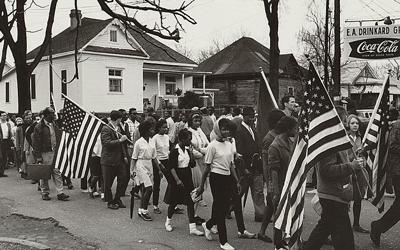
Description
The marches were organized by nonviolent activists to demonstrate the desire of African-American citizens to exercise their constitutional right to vote, in defiance of segregation. The marches were part of a broader voting rights movement underway in Selma, Alabama, and…
President Lyndon B. Johnson Signs 1968 Civil Rights Act, April 11, 1968

Description
The Civil Rights Act of 1968 was a landmark law in the United States signed into law by United States President Lyndon B. Johnson provided an avenue for equal housing opportunities regardless of race, creed or national origin and made it a federal crime to "by force or by…
March in Support of Migrant Workers in Des Moines, Iowa, February 1969
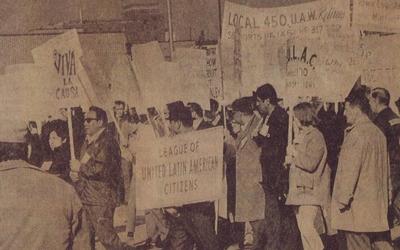
Description
Iowa LULAC councils, labor unions and migrant agencies marched in Des Moines to press for passage of migrant worker bills pending in the Iowa legislature. 1,500 activists marched in Des Moines in February 1969. This type of collective action pressured legislators to pass the…
"Iowa Constitution and Race" from Iowa PBS, 1978

Description
This video from Iowa PBS recreates how the Constitution of Delegates determined if African Americans would be welcome to Iowa.
Additional Resources
What key founding documents allow Americans participation in our democracy?
- Khan Academy: Democratic Ideals in the Declaration of Independence and the Constitution
This webpage offers perspective about the democratic ideals that led to the development of the Declaration of Independence and U.S. Constitution. - National Constitution Center: Educational Videos
This organization offers free educational video lessons that feature the museum's education staff, distinguished scholars and even some famous faces who bring America's democracy and the stories of "We the People" to life. - Prequel to Independence
This is a National Archives digital activity to sort documents and images related to the founding of the United States. - The Iowa Constitution from Iowa PBS
This webpage from Iowa PBS and Iowa Pathways focuses on the creation and implementation of the Iowa Constitution. - The Mini Page: Bill of Rights
This archived issue of The Mini Page - an educational children's newspaper - focuses on the Bill of Rights. - The Mini Page: Amendments 11-26
This archived article from The Mini Page - an educational children's newspaper - focuses on the Amendments 11 through 26 of the U.S. Constitution. - The Bill of Rights in Translation: What It Really Means by Amie Jane Leavitt
This book explains the meaning of the Bill of Rights for students. - The Declaration of Independence in Translation: What It Really Means by Amie Jane Leavitt
This book explains the meaning of the Declaration of Independence for students. - We the Kids: The Preamble to the Constitution of the United States by David Catrow
This book is helpful to inspire discussion in classrooms with an illustrated look at the Preamble of the U.S. Constitution and provides an accessible introduction to America's founding ideals for citizens of all ages.
How are laws created?
- Branches of the U.S. Government
This webpage includes infographics, texts and more to explain what the purpose and function of the branches of government are in the United States. - Engaging Congress
This online resource from Indiana University provides a teacher's toolbox, primary sources and more to teach students about Congress. - iCivics: Foundations of Government
Use this online resource to help students examine the purpose, forms and limitations on government. - "I’m Just a Bill" Video from Schoolhouse Rock
Watch this educational video from Schoolhouse Rock about how a bill is created and can become a law. - Iowa Judicial Branch: Justices
Learn about the history of the current Iowa Supreme Court justices. - Kid Citizen: Welcome to Congress
This resource from the Library of Congress looks at who represents the people in the U.S. Congress and where do they work. - "The History of the Iowa Capitol Building in Des Moines" Video from Iowa PBS
In this segment is from Iowa PBS' "This Old Statehouse" documentary, learn about the building of Iowa's historic capitol building.
How can laws be changed to guarantee human rights?
- Constitution Center: Tinker v. Des Moines
Use this video to learn about the landmark free speech case. - Dred Scott Case
This webpage from History.com focuses on the Dred Scott case, also known as Dred Scott v. Sandford, which was a decade-long fight for freedom by an enslaved man named Dred Scott. - iCivics: County Solutions Civic Action Plan
County Solutions is a lesson-based civic action project educators can do with their students right in the classroom. - Iowa Civil Rights Toolkit
Download this toolkit from the Iowa Civil Rights Commission to learn more about the state's civil rights history. - Khan Academy: Tinker v. Des Moines (1969)
This webpage from the Khan Academy provides an overview of the monumental U.S. Supreme Court case of Tinker v. Des Moines. - Marbury vs. Madison: What Was the Case About?
This video focuses on the 1803 U.S. Supreme Court case between William Marbury and James Madison. - Mary Beth Tinker Describes Her Experiences Participating in a Student Protest in 1965
Mary Beth Tinker describes the inspiration that led to her decision to participate in a student protest of the Vietnam War in 1965, along with recounting the events and experiences of the time. - Mary Beth Tinker Describes Her Work Raising Awareness of First Amendment Rights
Mary Beth Tinker describes how she came to the decision to begin public speaking to help raise awareness of First Amendment rights for young people. - Mary Beth Tinker Describes the Need to Understand First Amendment Rights
Mary Beth Tinker describes how she continues to see the need for young people to understand and practice their First Amendment rights. - My Civic Responsibility
In this lesson, learners identify different levels of participation in a democracy. - National Archives: Records of Rights
Explore records of the National Archives documenting the ongoing struggle of Americans to define, attain and protect their rights. - Ralph Montgomery from Iowa PBS
This webpage from Iowa PBS focuses on the Iowa Supreme Court case called "In the Matter of Ralph (a colored man)," which made history as the first decision of the Iowa Supreme Court in regard to a "fugitive slave." On Independence Day 1839, Ralph was declared a free man. - Selma to Montgomery March
This webpage from History.com focuses on the Selma to Montgomery march was part of a series of civil rights protests that occurred in 1965 in Alabama, a southern state with deeply entrenched racist policies. - Seneca Falls Convention
This webpage from History.com provides an informational overview of the Seneca Falls Convention in July 1848, which launched the women's suffrage movement in the United States. - The Women Who Shaped the Universal Declaration of Human Rights
Seventy years ago, Eleanor Roosevelt was instrumental in drafting the Universal Declaration of Human Rights. But she was not alone. Discover who are the women who shaped the major instrument for the defense of human rights through this video from the United Nations. - Universal Declaration of Human Rights
The Universal Declaration of Human Rights (UDHR) is a milestone document in the history of human rights. - Pride: The Story of Harvey Milk and the Rainbow Flag by Rob Sanders
In this empowering true story, young readers will trace the life of the Gay Pride Flag, from its beginnings in 1978 with social activist Harvey Milk and designer Gilbert Baker to its spanning of the globe and its role in today's world
Iowa Core Social Studies Standards (5th Grade)
Listed below are the Iowa Core Social Studies content anchor standards that are best reflected in this source set. The content standards applied to this set are elementary-age level and encompass the key disciplines that make up social studies for fifth-grade students.
| No. | Standard Description |
| SS.5.14. | Explain how various levels of government use taxes to pay for the goods and services they provide. |
| SS.5.24. | Explain probable causes and effects of historical developments. |
| SS.5.25. | Develop a claim about the past and cite evidence to support it. |